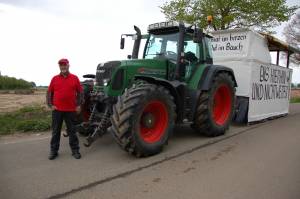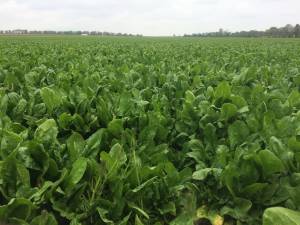Just outside the ghost village of Immerath, Nordrhein Westfalen, Germany at the #AntiKohleKette (Human Chain), 25th April 2015
 I’m not even sure how we began talking. I think I asked him if the tractor over there was his. It was. It was pulling a trailer decorated with banners showing the boundary where people are calling for the mine to end. I had seen it earlier trumbling along with two women singing “Billa lass uns tanzen bis der Bagger kommt, solang sich unsere Füsse drehen, bleibt die Erde stehn” – about dancing on the land to keep the diggers away.
I’m not even sure how we began talking. I think I asked him if the tractor over there was his. It was. It was pulling a trailer decorated with banners showing the boundary where people are calling for the mine to end. I had seen it earlier trumbling along with two women singing “Billa lass uns tanzen bis der Bagger kommt, solang sich unsere Füsse drehen, bleibt die Erde stehn” – about dancing on the land to keep the diggers away.
The tractor on its day out in protest, he humble in his red cap watching the crowd, me trying to protect various social media tools with my raincoat, and 5,998 or so other people trailing yellow ribbons were standing amongst fields of crops that in two to three years time, as it stands, will no longer exist. And his village – the village of Holzweiler – was a backdrop to the solemn scene. He did not know yet whether his land would too be pulled up to dig the coal from beneath it.
I heard one activist tell a crowd , “These are open cast mines. That means the coal is not extracted from digging down below the surface. Instead, you clear the surface and anything that is on it to get at the coal. That means fields, homes, hospitals, churches, forests, you name it, it goes.”
, “These are open cast mines. That means the coal is not extracted from digging down below the surface. Instead, you clear the surface and anything that is on it to get at the coal. That means fields, homes, hospitals, churches, forests, you name it, it goes.”
The farmer, maybe the same age as my dad, told me the worst thing was not knowing. How do you plan or deal with a situation if you don’t know if in a few years time you and your family will be relocated? Moreover, how does that actually practically happen? How can you replace someone’s field and crops? How can you replace someone’s home, history, and livelihood? He said, for him maybe it wasn’t so bad, but what about his son? What was he going to do?
If we close the mines, hundreds of jobs will be lost we are told. But here I hear stories of not just jobs being lost indirectly as a result of mine expansion, but also communities. And it’s done with dirty tactics. Herr Schmitz, the farmer, told me RWE – the utility company who owns the Rhineland coalfields – comes into communities years in advance of demolition. When villagers were offered compensation for relocation, their initial reaction was resistance, as you can imagine. “But time softens them,” said Herr Schmitz. RWE begins to cut things down in the surrounding area, already destroying what they can access, making it feel like the work is already underway. Then some people take the offer, and a few people begin to leave, and so local businesses begin to lose their local customers. How can the baker stay open as the village slowly dissipates? Once the first few go, it has a domino effect.
Our other backdrop is the village of I mmerath. It has a strange atmosphere. It’s eerie because it’s boarded up and pieces of yellow ribbon line the streets tied to door handles and garden gates. Showing respect for the village. And for an afternoon the protesters bring some colour, there to resist the expansion of the coal mine because of its climate impacts, its pollution and health impacts, and its destruction of local communities.
mmerath. It has a strange atmosphere. It’s eerie because it’s boarded up and pieces of yellow ribbon line the streets tied to door handles and garden gates. Showing respect for the village. And for an afternoon the protesters bring some colour, there to resist the expansion of the coal mine because of its climate impacts, its pollution and health impacts, and its destruction of local communities.
He points to a building and tells me it used to be a hospital. Now it’s empty and boarded up. In this village a few residents remain in resistance, but there are no shops left, nor church, nor other local services.
He tells me another four villages, hundreds of year s old, are due to be demolished over the next 15 years. He takes me round to the other side of his tractor to show the other banner which names those different villages and those – like his – that are under question.
s old, are due to be demolished over the next 15 years. He takes me round to the other side of his tractor to show the other banner which names those different villages and those – like his – that are under question.
Mr Schmitz took part in his first human chain here almost exactly 30 years ago. And he’s still resisting. It filled me with sadness talking to him, but maybe the seasons are changing and we are on the winning side now. RWE is in €31 billion of debt; the cost of coal is becoming increasingly expensive, not to mention when you add the external costs of transport etc; climate change concerns mean that limitations are being made on coal emissions and we’re realising to exactly what extent we can’t burn the black stuff (90% of coal reserves in Europe need to stay in the ground if we want stay below 2 degrees warming). And well there’s an ever growing movement ready to resist.
I really warmed to Mr Schmitz who left me with his address in case I ever wanted to visit his family and farm. And I waved him and his tractor off, vowing to write this blog and share his story, so people would know more about why we’re feeling the need to go to the scale of climbing into a 400m-deep coal mine this 14-16th August and stop the largest diggers on earth. If you want to hear more about the action, take a peek here.
Special thanks to Mr Schmitz for taking the time to share his story with me on that Saturday afternoon and thanks to all of you who will help share it. Mr Schmitz, I think we will meet again.

